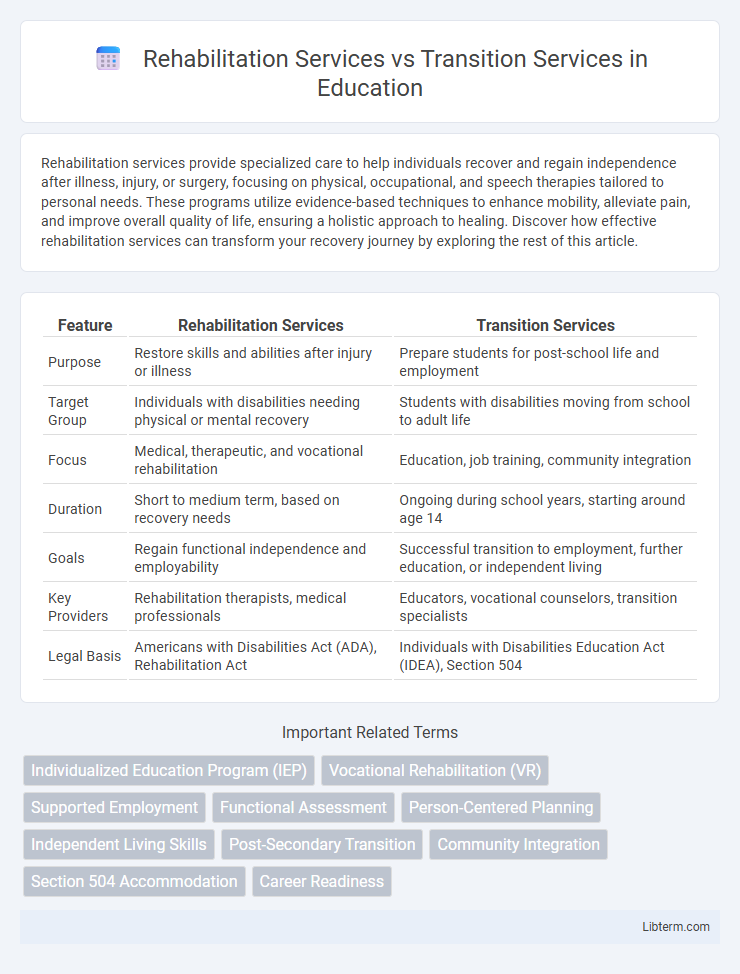Rehabilitation services provide specialized care to help individuals recover and regain independence after illness, injury, or surgery, focusing on physical, occupational, and speech therapies tailored to personal needs. These programs utilize evidence-based techniques to enhance mobility, alleviate pain, and improve overall quality of life, ensuring a holistic approach to healing. Discover how effective rehabilitation services can transform your recovery journey by exploring the rest of this article.
Table of Comparison
| Feature | Rehabilitation Services | Transition Services |
|---|---|---|
| Purpose | Restore skills and abilities after injury or illness | Prepare students for post-school life and employment |
| Target Group | Individuals with disabilities needing physical or mental recovery | Students with disabilities moving from school to adult life |
| Focus | Medical, therapeutic, and vocational rehabilitation | Education, job training, community integration |
| Duration | Short to medium term, based on recovery needs | Ongoing during school years, starting around age 14 |
| Goals | Regain functional independence and employability | Successful transition to employment, further education, or independent living |
| Key Providers | Rehabilitation therapists, medical professionals | Educators, vocational counselors, transition specialists |
| Legal Basis | Americans with Disabilities Act (ADA), Rehabilitation Act | Individuals with Disabilities Education Act (IDEA), Section 504 |
Introduction to Rehabilitation and Transition Services
Rehabilitation Services focus on helping individuals with disabilities develop skills and achieve independence through therapeutic, educational, and vocational training. Transition Services prepare students with disabilities to move smoothly from school to post-school activities, including higher education, employment, and community participation. Both services aim to enhance quality of life but target different stages of personal and professional development.
Defining Rehabilitation Services
Rehabilitation services encompass a range of therapeutic and support interventions designed to help individuals with disabilities regain, maintain, or improve their functional abilities for daily living and employment. These services may include physical therapy, occupational therapy, speech-language pathology, and vocational training tailored to enhance independence and quality of life. Rehabilitation focuses on restoring skills and capabilities lost or impaired due to injury, illness, or disability, distinct from transition services that primarily prepare youth for post-secondary education, employment, and independent living.
Defining Transition Services
Transition services are a coordinated set of activities designed to prepare students with disabilities for post-secondary life, including education, employment, and independent living. These services focus on skills development, goal setting, and connecting students with community resources to ensure a successful move from school to adult roles. Rehabilitation services, by contrast, provide specialized support and therapy to improve functional abilities and independence for individuals with disabilities.
Key Objectives of Rehabilitation Services
Rehabilitation Services aim to restore individuals' functional abilities and enhance independence through targeted therapies, vocational training, and medical care, addressing physical, cognitive, and emotional impairments. These services focus on maximizing recovery potential and improving quality of life by customizing interventions based on individual needs. Rehabilitation prioritizes skill development and adaptation to overcome disabilities, facilitating reintegration into daily activities and work environments.
Key Objectives of Transition Services
Transition Services are designed to prepare students with disabilities for post-school life by focusing on education, employment, and independent living skills development. Key objectives include individualized planning, linking students to community resources, and fostering self-advocacy to ensure a successful shift from school to adult roles. Rehabilitation Services, in contrast, often concentrate on restoring or enhancing functional abilities to support employment and daily living after injury or disability onset.
Target Populations for Each Service
Rehabilitation Services primarily target individuals with physical or mental disabilities seeking to regain skills and independence for employment or daily living, including adults and youth with disabilities. Transition Services focus on students with disabilities aged 14 to 22, preparing them for post-secondary education, vocational training, and employment through coordinated school-to-work programs. Both services aim to enhance functional capabilities but address distinct age groups and stages in the disability support continuum.
Core Components and Approaches
Rehabilitation services focus on restoring or improving physical, mental, and cognitive abilities through therapies, skill development, and vocational training to enhance independence. Transition services are designed to assist individuals, especially youth with disabilities, in moving from school to post-school activities, incorporating education, employment, and community participation planning. Core components of rehabilitation emphasize medical and therapeutic interventions, while transition services prioritize coordinated planning, goal setting, and collaboration between schools, families, and community resources.
Comparing Service Delivery Models
Rehabilitation services center on providing medical, therapeutic, and vocational support to help individuals recover skills and regain independence after injury or illness, typically delivered through clinical and community-based programs. Transition services focus on assisting individuals, particularly youth with disabilities, in moving from school to postsecondary education, employment, and independent living, emphasizing coordinated planning, skill development, and interagency collaboration. Rehabilitation models often prioritize individualized therapy and medical intervention, while transition services emphasize educational planning, job training, and connection to adult service systems to ensure successful societal integration.
Outcomes and Effectiveness
Rehabilitation Services primarily aim to restore functional abilities and improve physical, cognitive, or emotional capacities, resulting in increased independence and quality of life for individuals with disabilities or injuries. Transition Services focus on preparing individuals, especially youth with disabilities, for post-school activities including employment, education, and independent living, with goals centered on successful integration into adult roles. Studies demonstrate that tailored Transition Services significantly enhance post-secondary employment and education outcomes, while Rehabilitation Services show effectiveness in reducing disability limitations and fostering long-term health improvements.
Choosing the Right Service for Individual Needs
Choosing between Rehabilitation Services and Transition Services depends on the individual's current stage and specific goals; Rehabilitation Services focus on restoring skills and independence after injury or illness, while Transition Services assist students with disabilities in moving from school to adult life, including employment and education planning. Evaluating personal needs, such as the necessity for skill recovery or support in educational and vocational planning, ensures the selection of the most effective service. Tailoring the approach to individual circumstances maximizes outcomes and supports long-term success.
Rehabilitation Services Infographic

 libterm.com
libterm.com